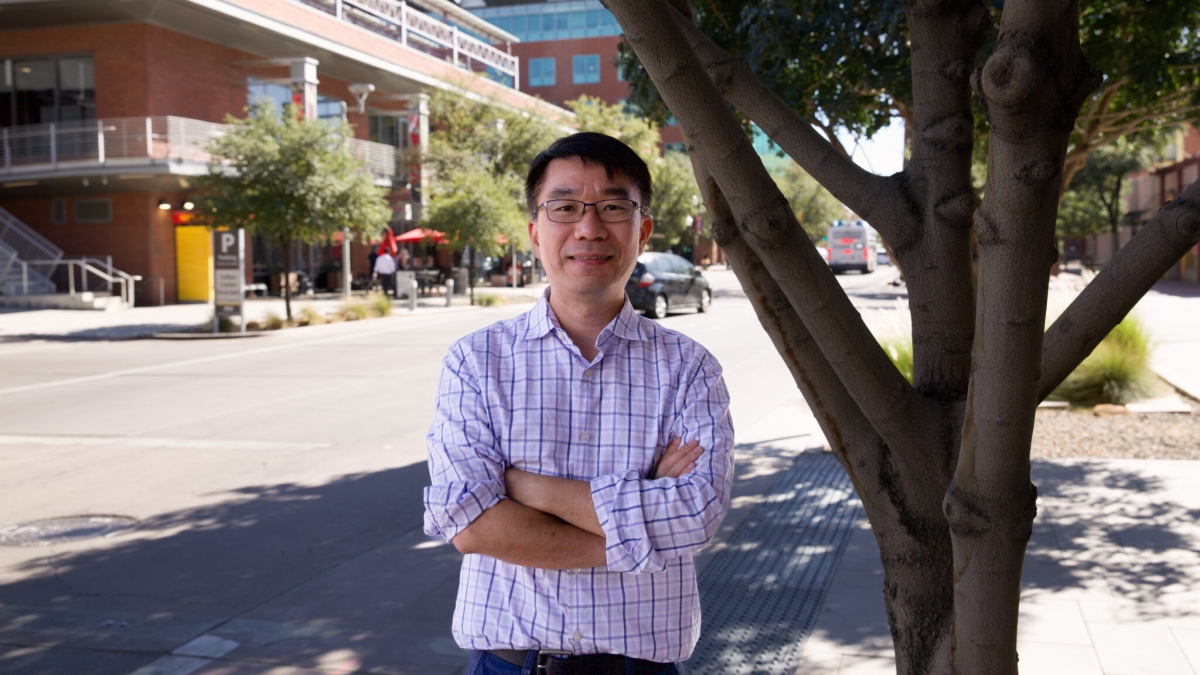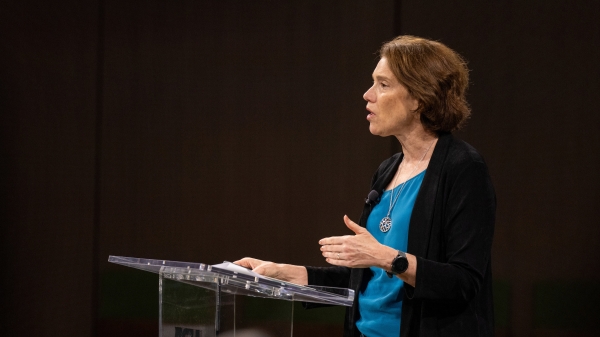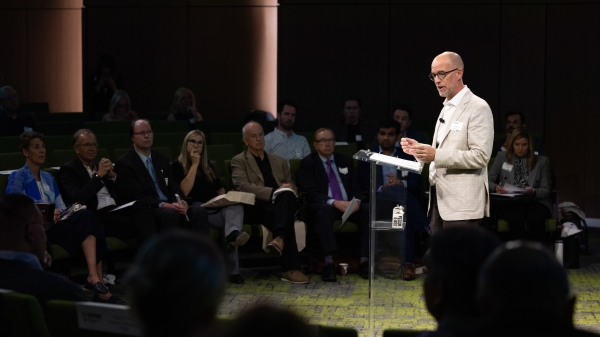Tackling traffic with open-source mobility solutions

Professor Xuesong Zhou stands along a street featuring multiple modes of transportation. Zhou leads an interdisciplinary team developing open-source systems that help cities build multimodal transportation that is equitable and sustainable. Photo by Bobbi Ramirez/ASU
Traffic congestion, bad air quality and lack of mobility options are some of the most critical issues affecting transportation in the United States.
Helping municipalities develop equitable and sustainable transportation solutions to address these challenges is the main focus of an interdisciplinary team led by Xuesong Zhou, a professor of civil, environmental and sustainable engineering in the School of Sustainable Engineering and the Built Environment, part of the Ira A. Fulton Schools of Engineering at Arizona State University.
“We are not just a population of drivers,” Zhou says. “Communities have many different layers of transportation needs. We want to provide a complete vision.”
The National Science Foundation, or NSF, recently awarded $1.5 million to the team to develop multimodal mobility solutions for transportation infrastructure. The grant is part of the Pathways to Enable Open-Source Ecosystems, or POSE, program, which aims to support the translation of research into accessible and sustainable open-source systems for addressing national societal challenges.
Zhou, the project’s principal investigator, and his team are developing the "Consortium of Open-source plaNNing models for Next-generation Equitable and efficient Communities and Transportation," also known as CONNECT. The consortium unifies metropolitan planning organizations, government transportation engineers, computing researchers, open-science educators and optimization scholars.
CONNECT aims to standardize transportation data to make it more accessible to decision-makers and the public at large. The team’s solution will help municipalities make informed, timely transportation and infrastructure improvements to address equity and sustainability goals.
“One of the most exciting and innovative aspects of this project is the development of interoperable and standardized solutions that enable transportation researchers to easily exchange, integrate and reuse multimodal datasets created by others,” says WenWen Li, a co-investigator on the project and a professor who leads the CyberInfrastructure and Computational Intelligence Lab in ASU’s School of Geographical Sciences and Urban Planning.
“Our approach significantly reduces data processing and preparation time, accelerating the problem-solving process for complex transportation challenges and better serving the diverse needs of communities,” Li says.
Reflecting community needs
The CONNECT project proposal states that a healthy and equitable society requires a variety of mobility options, including walking and cycling for short distances, public transit for longer trips and driving or riding vehicles only when necessary.
Zhou says most areas have a transportation infrastructure designed primarily for personal vehicles. The result is that people who do not own a vehicle or cannot operate a vehicle due to age, finances or disability are limited in their ability to travel.
“We see the need for mobility options due to the increasing number of older people and higher percentage of disabled or low-income people in our population,” Zhou says. “People actually spend more of their income on transportation expenses when they don’t have vehicles and are limited on transit options.”
Still, government agencies responsible for infrastructure planning are often unable to quickly meet the community’s transportation needs because of a lack of time, funding and workforce availability.
Issues involving budget constraints, permitting, data collection and collaboration lead to projects being addressed only when they become a critical priority. This often means decisions are made as a result of reactive planning or urgency due to a high amount of traffic or safety issues.
Zhou says communities with smaller populations may have only one person creating plans for populations of 50,000 or more.
“They are very busy,” Zhou says. “We’re trying to make sure one person can make multimodal infrastructure plans happen.”
How CONNECT helps
The CONNECT project would help communities develop plans based on real data collected through an open-source ecosystem.
“The transportation field has both an innovative community of researchers that pushes the methodological boundaries and a large and vibrant community of practitioners that applies transportation models for a variety of forecasting and policy-making purposes,” says Andre Carrel, a co-investigator on the project and associate professor at the College of Engineering at The Ohio State University.
But moving scientific advances into practice is often slow, with practitioners having difficulties adopting researchers’ new modeling frameworks into practical applications, Carrel says.
He notes that open-science principles allow practitioners to more easily review and adapt code and models created by researchers.
“Building a transportation science-oriented, open-source ecosystem is invaluable not only for the research community but also for stakeholders and the many local and underserved communities our solutions aim to serve,” Li says. “That said, this project requires a tremendous amount of effort.”
Li commends Zhou for his dedication to contributing to and advancing this open-source ecosystem.
“Our team, composed of interdisciplinary experts, including transportation engineers, computer scientists, optimization researchers, geospatial information scientists and representatives from government and nonprofit organizations, reflects ASU’s core values of cross-disciplinary innovation and societal impact,” Li says.
With this open-source ecosystem, transportation planners would save time collecting data and spend more time applying their limited resources toward solutions that meet the needs of their community.
“It considerably reduces the barriers and effort involved in inspecting and understanding the data and code that underlie a scientific advance, which in turn makes it more likely that modeling innovations will be picked up by practice,” Carrel says.
The multimodal plans enabled by the program will show how a road or transit line can be optimized to meet the community’s needs. The data will be presented in a format that can be interpreted easily by anyone.
“This is better than just literally walking through the city hall trying to propose planning solutions based on an opinion of how the roads should be constructed in your community,” Zhou says. “You don’t have to wait for somebody to want to make a change.”
The CONNECT solution also seeks to eliminate nearly all the manual processes that have been barriers in multimodal transportation planning.
“The definition of an ecosystem is that you have different types of contributors,” Zhou says. “I tried to facilitate a vision that is for the community, by the community.”
Lisa Irish, Monique Clement and Bobbi Ramirez contributed to this story.
More Environment and sustainability

Researcher works on changing people's mindsets to fight climate change
Meaningful action to heal the climate requires a complete shift in the way people think and perceive each other, according to an expert on social transformation who spoke at Arizona State University…

NOAA, ASU offer workshop to bridge ocean exploration, education
Oceans are vital to sustaining life on Earth, as they produce over half of the oxygen we breathe and play a crucial role in regulating the planet's climate. They also support a diverse array of…

A united front for sustainability and the economy
When four leaders of esteemed learning institutions and the mayor of Phoenix gather in one location at the same time, it’s a tip-off that something big is going down.When they’re joined by visionary…